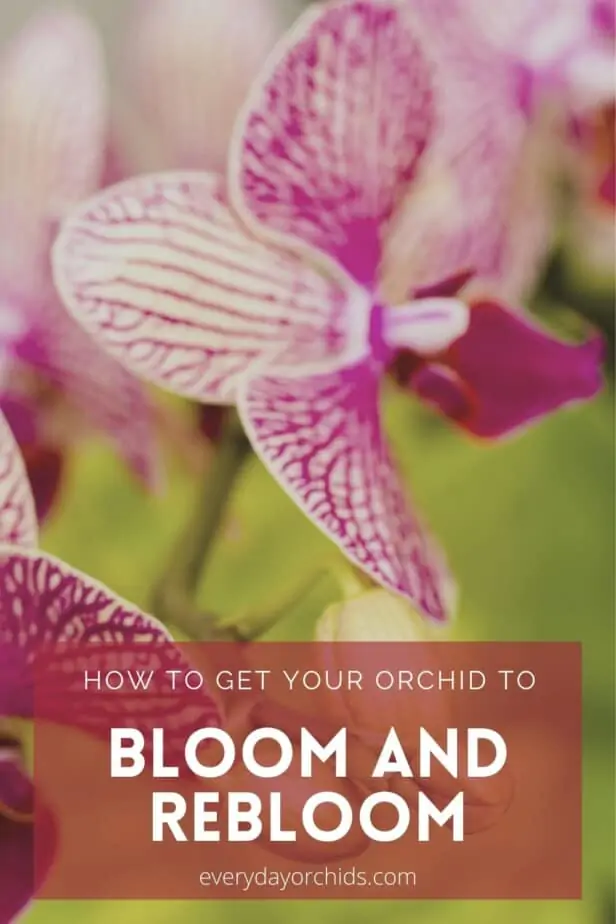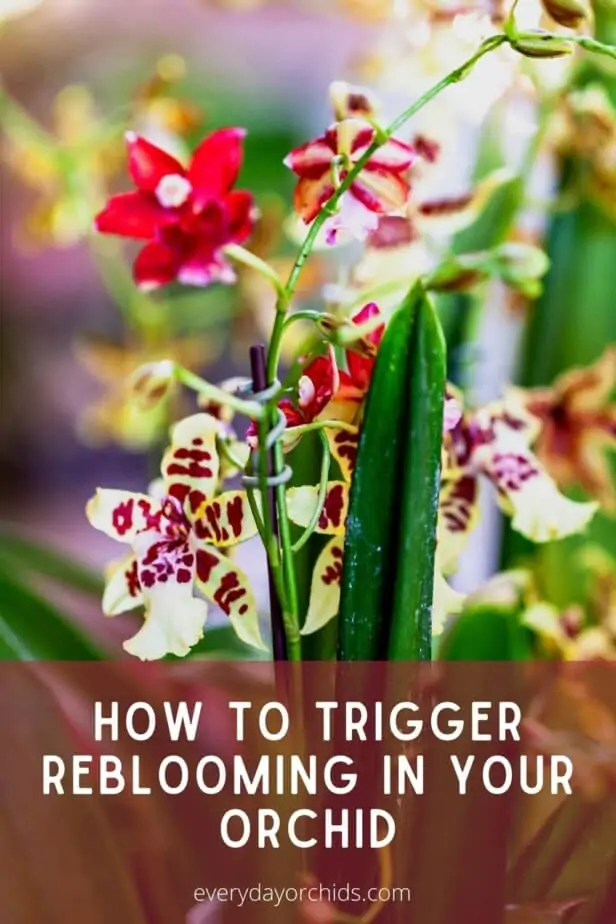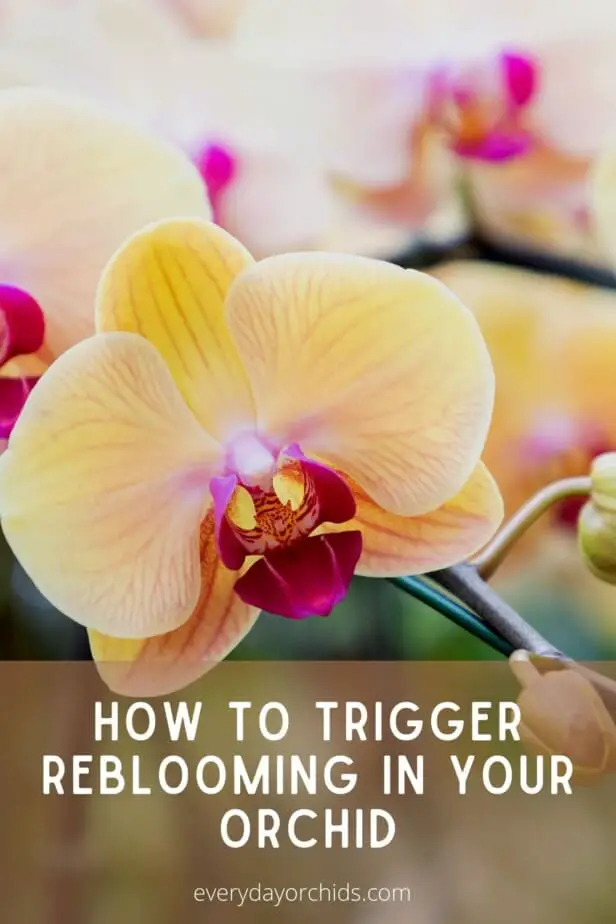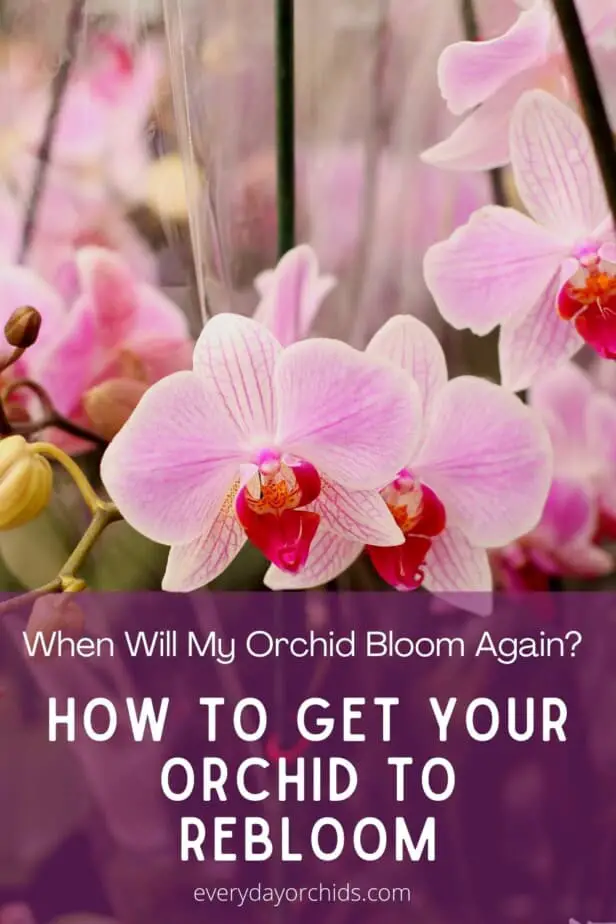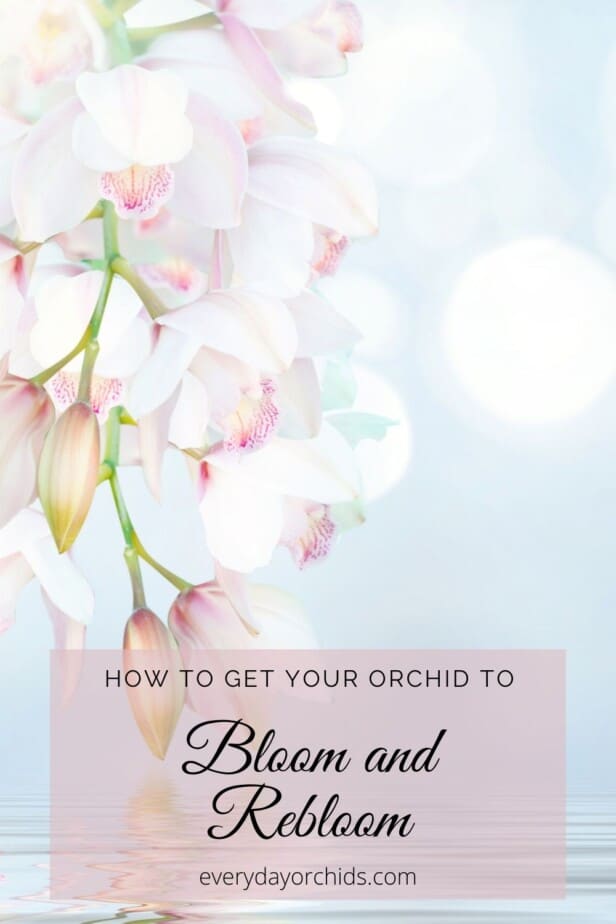If you are struggling to get your orchids to bloom or rebloom, you have come to the right place. Orchids have a reputation for being finicky flowers. If you haven’t been able to get your orchids to rebloom, it just might be a matter of making a few simple adjustments to your orchid care. Let me show you what to do to get your orchids to bloom again.
To get orchids to bloom or rebloom, there are several things you can do. Identify the proper lighting, watering schedule, potting specifics, and temperature preferences for your particular orchid species. Most orchids need a temperature drop at night to trigger production of a flower spike. Regularly fertilizing and monitoring your orchid’s nutrient levels will also help ensure that your orchid blooms frequently and on time.
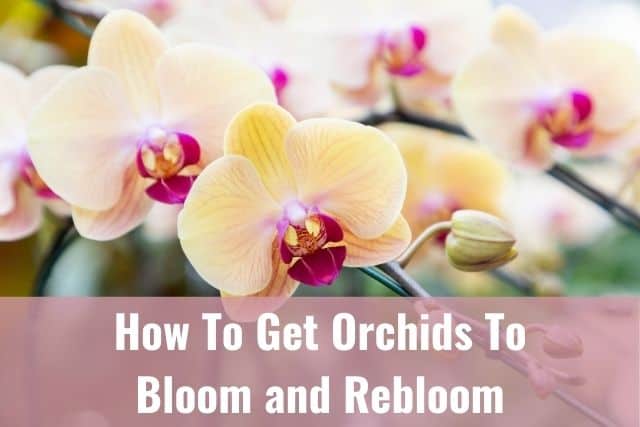
Tailoring your orchid care to your orchid’s preferences is essential. Doing so will encourage your orchids to bloom and rebloom seasonally. With the few simple care techniques I’ll outline in this article, I’ve been able to get my orchids to bloom and rebloom every year, and on rare occasion, twice a year. This can be you too. If you take good care of your orchid, it will produce a bounty of flowers every year for many years to come. Keep reading to learn some ways you can get your orchid to bloom and rebloom.
Please note that these links are affiliate links and as an Amazon Associate, I earn from qualifying purchases. Purchases made through affiliate links in this post may generate commissions at no additional cost to you. Use this link for a discounted Amazon Prime trial. Thank you for your support!
Table of Contents
How Do You Keep Orchids Blooming?
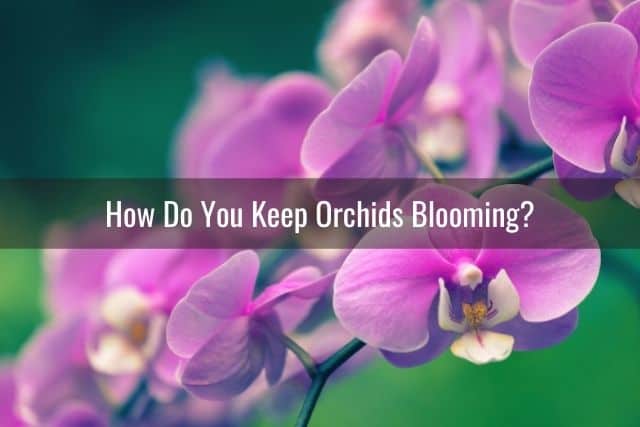
Orchids bloom seasonally. However, certain conditions can keep your orchid from blooming on time. If your orchid is not producing flowers, there are things you can do to help it rebloom. I’ll go over some top reasons why an orchid might not be blooming or reblooming. This way, you’ll know what to watch out for.
Know the Species of Your Orchid
First of all, you need to know what kind of orchid you are dealing with. Did you know that there are over 25,000 species of orchids? Each of these species grows in a different environment with different temperature, humidity, lighting and watering needs.
Knowing the conditions that your orchid naturally grows in is fundamental to taking proper care of your orchids and getting your orchid to bloom and rebloom.
Generally, orchids are tropical flowers. They can grow at the bases of trees, rocks, and other places where their roots can absorb high nitrogen quantities. There are other species of orchids can grow in the desert, near the sea, in cold climates, and in hot climates.
If you know your orchid’s species and particular growing conditions, you will be able to tailor your growing conditions to meet your orchid’s needs. In doing so, you will be able to help it produce more flowers.
Inadequate Lighting
If your orchid is not blooming, it might be because it isn’t getting enough light. If the leaves on your orchid plant are a darker shade of green than usual, then that probably means your orchid needs more light. Dark green leaves in an orchid are a sign of inadequate lighting.
Most orchids need exposure to at least 6 hours of bright light each day. Ideally, 12-14 hours of bright, indirect light is best.
To address this, place your orchid next to a bright window that gets partial sunlight. Alternatively, you can purchase a grow light for your orchid.
If you need to supplement with artificial lighting, you can use something like Amsun’s Grow Light for potted plants. This handy little grow light can clip right on to your orchid’s pot. It allows you to adjust the strength of the light and has an automatic self-timer.
Too Much Light
Orchids thrive in bright light, but too much light can also be bad for your plant. The intense afternoon sunlight can burn orchid leaves. For example, if your orchid has yellowing or brown leaves, then it may have been exposed to too much light. To learn more, read this article about what orchid leaf color means, and what you can do about it.
Too much light is bad for orchids simply because burned, yellowing, or damaged orchid leaves will not be able to perform photosynthesis properly. This, in turn, prevents the orchid from harvesting the energy it needs to produce a flower spike. An orchid plant under stress will be less likely to flower. If too much light is the problem, an easy fix is to move your orchid somewhere with less light or indirect sunlight.
To ensure that your orchid is getting the right amount of sunlight, place it in a window that faces east. Putting your orchid in an east-facing window will ensure that it gets the mild, bright morning light. It will also allow your orchid to avoid the hot, direct afternoon sunlight. Your orchid will get enough hours of the bright, indirect light that it needs without needing you to invest in additional lighting.
Not Enough Nutrients
If your orchid is not getting enough nutrients, it will not bloom. Fertilizing orchids is a key part of orchid care.
Generally, orchids do not need much fertilizer. However, over time, they do need a little bit of extra nourishment to keep blooming and produce blooms.
When you fertilize, make sure that you are using a fertilizer designed for orchids. Orchids require nitrogen and other minerals to grow. Follow the instructions on the orchid fertilizer container for how to prepare your orchid fertilizer. Then further dilute your orchid fertilizer to quarter-strength with more water.
You can fertilize your orchids “weekly, weakly.” This means you water your orchids first, then feed your orchids with a diluted amount of fertilizer each week.
Should You Use A Bloom Booster Fertilizer?
To increase the chances that your orchid will successfully produce flowers, you can use a bloom booster fertilizer. Bloom booster fertilizers, such as this one, are specially formulated to encourage flower spike production. These fertilizers typically have a higher concentration of phosphorus, which is important. Phosphorus aids in bloom production in orchids and is essential in other key functions.
The best time to apply a bloom booster fertilizer would be late summer or early fall, or about three months before your orchid typically blooms. In fact, I recommend incorporating this as part your basic fall care for your orchid plants each year.
You would only want to use a bloom booster fertilizer once a month or so during the late summer or fall months. A bloom booster orchid fertilizer will strengthen up your orchid for the winter months. By late November or early December, you will want to switch back to a regular orchid fertilizer.
If you are interested in learning more, check out this guide on how to fertilize your orchid and this guide on how to make your own orchid fertilizer using kitchen scraps.
Orchid Needs Repotting or Was Just Repotted
In general, you should wait until after your orchid is done blooming to repot your orchid. However, there are times when repotting can’t be postponed.
An example of this is root rot. Over time, the orchid media will start to decompose and break down into smaller pieces. As a result, the amount of air circulation around your orchid’s roots decreases. This can lead to root rot.
If your orchid’s roots look brown or soggy, you likely have root rot. You will need to repot your orchid and prune off the rotted roots. Be sure to also use new orchid potting media when you repot your orchid.
In addition, if your orchid’s roots have outgrown it’s pot, then you will need to repot it. Sometimes, orchids will only bloom if their roots are packed tightly into their pot. However, if any of these roots start to grow outside of the pot, then it is time to upsize. Generally, it is good to only increase the pot’s size by 1-inch every time you repot. In this case, though, I would wait to repot until after your orchid is done blooming.
If you have recently repotted your orchid, all of its energy will now be focused on re-establishing its roots. This is one major reason why an orchid might not bloom after it has been repotted.
Why Orchids Might Not Rebloom After Being Repotted
Orchid roots are very complex, and growing new roots requires a lot of the plant’s energy. Give your orchid the time that it needs to re-establish its roots before you expect it to bloom again. Repotting can be very stressful for orchids.
Your orchid might skip blooming this year as it rebuilds its energy stores. Don’t worry, this is perfectly normal after an orchid is repotted. It is just focusing its energy on root and leaf growth instead of bloom production.
Just a reminder, whenever you re-pot an orchid, do not use potting soil. Orchids require special orchid potting media to grow. For more information, read this guide to choosing the best potting media for your orchid.
You can get orchid potting media at your local garden center. You can also buy orchid potting media such as Perfect Plant’s Organic Orchid Potting Soil online. This has a good mixture of tree bark, perlite, and stones.
Too Much or Too Little Watering
An orchid that receives too much or too little water will have difficulty producing blooms. Too little watering is seen in wilted or limp leaves, or dried, shriveled roots. Too much watering leads to brown, soggy roots, or an orchid dropping its buds before they fully bloom.
If your orchid shows signs of too little or too much watering, here are some tips on how to water your orchid. Your orchid’s pot size and the weather will determine how often you should water your orchids. Usually, in warm or dry weather, you can water your orchids once or twice a week.
Winter care for orchids will be slightly different than the rest of the year. Same for orchid care in the fall. In the fall and winter, water your orchids less frequently, such as every 7 to 10 days. Make it a point to water your orchids early in the day. This will allow them to dry out before night time.
Like most plants, orchids need to dry out between waterings. They should never be left to sit in pools of water. It is important to empty the saucer or tray under your orchid pot after watering. This will help prevent rot, bacterial and fungal infection, and more.
How To Know When To Water Your Orchid
If you are unsure if your plant needs water, you can find out easily if it is time to water your orchid. Do this by placing a finger in the potting media. If the potting media is dry, it likely is ready to be watered. If it is still damp from the last watering, wait another day or two and check again before watering.
Most orchid plants are grown in plastic orchid pots. Another way you can determine if it is time to water the plant is by simply lifting the orchid. If it is light, it likely needs to be watered. If it is heavy, it does not.
The larger the pot, the less frequently you should water your orchids. The longer you have your orchids, the easier it will be to know when and how often your orchid needs to be watered.
How To Trim or Prune Orchids To Encourage Reblooming
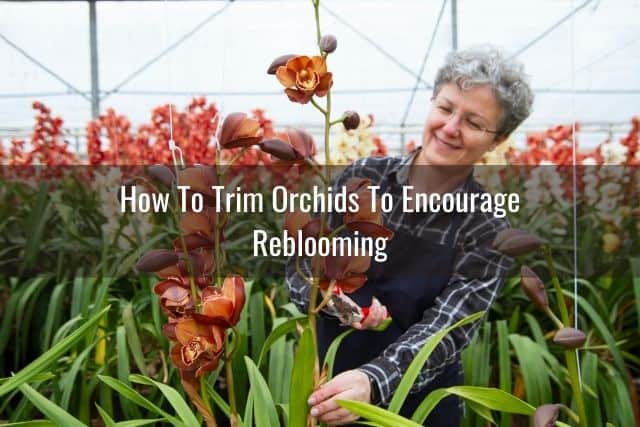
Did you know that you can prune your orchid in a way that would trigger it to rebloom? Once your orchid has bloomed, it will leave a bare stem or spike that the flowers had once bloomed on. After each bloom, you can trim back the spike to encourage your orchid plant to respike and bloom again.
When all of the blooms have fallen off of your orchid, it is time to trim back the spike. It is crucial to prune your orchid’s spike correctly and with clean gardening shears. Always clean and disinfect your gardening tools after using. Orchids can get viruses or infections when their spikes are cut incorrectly.
Always use a sterilized knife or gardening shears when pruning your orchid. This will help you avoid infecting your orchid with trace amounts of bacteria, fungi or mold. Seal off the cut ends of the orchid with an anti-fungal powder such as ground cinnamon.
To prune your orchid and trigger reblooming, follow these steps: Once your orchid has bloomed, find the node from where the last, lowest flower bloomed. Trim the spike 1 inch below this. Leave at least 1 inch above the remaining node for a new spike to form. Pruning your orchid in this way will encourage your orchid to produce a new flower spike. It can even result in the formation of new blooms on the same spike that you just trimmed.
What Temperatures Will Produce An Orchid Flower Spike?
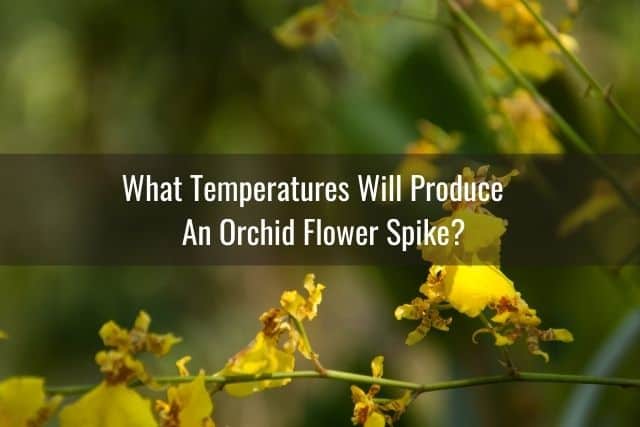
I alluded to this earlier, but a change between day and night temperature is necessary to trigger blooming in your orchid. Let’s go over this some more.
Most orchids are tropical plants, which means that they will grow better in warmer temperatures. During the day, you can keep your orchids at a temperature of about 75° F (24° C). During the night, however, orchids will need to experience cooler temperatures to trigger a blooming spike to grow.
Generally, a drop of about 10° F (5.6° C) to 20° F (11.2° C) during the night will be sufficient to trigger your orchid to rebloom.
Different species of orchids naturally grow in different climates. Therefore, you should still try to keep your orchids at temperatures that are similar to their native environments. The above temperatures are just a general guideline. Research your specific orchid species and find out what its day and night temperature tolerances are.
I have provided information about temperature tolerance ranges for popular orchids in other articles. Just do a search on my Everyday Orchids site for “temperature tolerance” to find those.
Sometimes your natural climate will interfere with your orchid’s ability to grow. If the temperature is too hot or too cold, your orchid will remain dormant and will not bloom.
Here is a general guide to the temperature extremes that various species of orchids can withstand:
| Warm Growing Orchids | Intermediate growing Orchids | Cool Growing Orchids | |
| Winter Low | 65° F (18° C) | 58° F (14.4°C) | 50°F (10°C) |
| Summer High | 85° F (29° C) | 80°F (27° C) | 80°F (26.6° C) |
Keeping your orchid at an appropriate temperature is key to getting it to bloom. If your orchid is exposed to extreme hot or cold temperatures, it could stop blooming and even die.
What Are Some Treatments for Cold Injuries in Orchids?
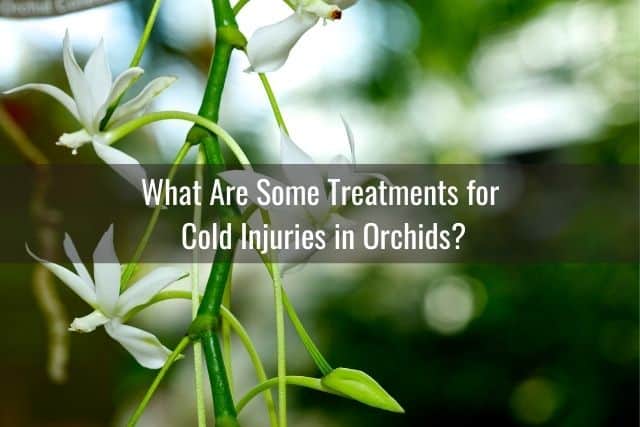
There are two different injuries that orchids can suffer from due to extreme temperature exposure during wintertime. A cold injury occurs when orchids are exposed to very cold temperatures. It can result in damage to your orchid’s leaves. Frost damage occurs when your orchids are exposed to freezing temperatures. Frost can quickly kill an orchid plant.
Orchids with cold injuries usually show clear signs of their injury. Your orchid may have brown, mushy spots on its leaves or roots. It may also have lesions on its leaves, a fungal infection such as fusarium wilt, or stunted growth. If you notice any of these signs, trim off any leaves with visible damage or discoloration.
If your orchid has a frost injury, its leaves may have spots of rotted tissue. Parts of the plant may have died. Trim off the affected areas after treating your plant for temperature damage.
Suppose your orchid is exposed to extreme temperatures. In that case, it will need to be treated for any injuries as soon as possible. Most orchids cannot survive in extreme temperatures. Some species cannot even survive at temperatures lower than 65° F (18° C). If your orchid is exposed to cold temperatures, you can take some steps to help it recover.
Treatment For Cold Injuries and Cold Exposure
- Remove your orchid from the cold environment.
- Place your orchid in a humid environment. You can put a plastic bag with just a few punctured holes in it over your plant to maintain humidity.
- Place your orchid out of direct sunlight.
- Let your orchid’s soil dry out to medium moisture.
- Do not water your orchid until it shows new growth.
- After your orchid has sprouted new leaves, you can resume watering it as usual. Gradually introduce it back to sunlight.
Any orchid suffering from a frost injury or a cold injury may not bloom the following season. Give your orchid time to grow back its damaged leaves and recover. Treat it with extra care as it gains back its strength.
Should You Trim Orchid Spikes and How?
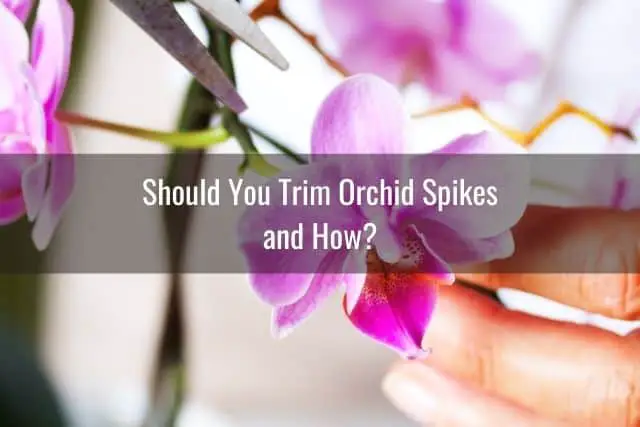
So what other things can you do to get your orchids to bloom and rebloom? Well, once your orchid has bloomed, you can trim, or prune, the flower stem. This will allow your orchid plant to refocus its energy on bloom production.
When you trim your orchid spikes, it is important to make sure that you do it correctly. This will give your orchid a greater chance of reblooming.
The color and condition of the orchid spike will determine where you trim it.
- If the spike is still green, trim your orchid 1 inch below where the lowest bloom was. Usually, cutting here will allow the same spike to regrow flowers. Your orchid should reflower in 8 to 12 weeks.
- If the spike is brown, it will not rebloom. You can trim it off at the base of the plant. You should see regrowth in about a month.
- If your orchid has a double spike, trim one of the spikes 1 inch below the lowest bloom. Cut off the other one at the base so the orchid can focus its energy on the remaining spike.
Properly pruning your orchid’s spike is essential. Leaving bare spikes on your orchid may keep it from reblooming.
Check out this article about orchid spikes for more information about orchid spike problems.
How To Make Orchids Grow Faster

Sometimes you will not be able to force an orchid bloom out of season. However, there are several ways that you can make your orchids grow faster. This in turn will help your orchid with bloom production.
Helping your orchids grow more quickly can trigger them bloom on time and even rebloom. By encouraging growth and energy storage during dormancy, you are preparing your orchid for success. By the time blooming season rolls around, your orchid will be primed to produce flower spikes and multiple blooms.
Here are some ways you can help encourage growth in your orchid:
- Give your orchids at least 9 hours of light a day. Adjusting your orchid’s exposure to light will encourage it to grow faster and taller. Exposure to lots of bright, indirect light will encourage growth of flower spikes and blooming. There are certain wavelengths of light that can trigger flower production.
- Make the room warmer. Increasing the heat will encourage the spikes to grow faster. However, never raise the heat above 80°F (27° C) as this will dry out your orchid.
- Stake your orchid’s spikes. If you prop your orchid’s spikes onto stakes, your plant will spend less energy on strengthening its spike. As a result, it will grow taller that much faster.
- Clip off flowers from your orchid. Even orchids that do not rebloom may grow back flowers that have been clipped off.
- Trim your orchid’s spikes after every bloom. Trimming your orchid’s spikes will allow your orchid to focus on reblooming.
Inducing growth can strengthen your orchids and encourage them to bloom and rebloom.
When Will My Orchid Bloom?
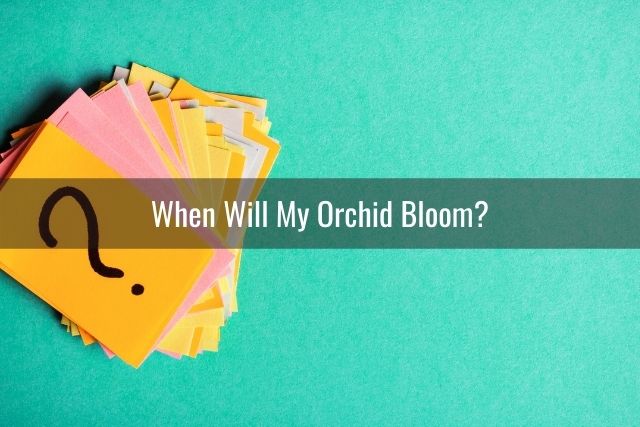
Different species of orchids will rebloom during different times of the year. Buying an orchid in bloom does not necessarily mean that it will rebloom at the same time the following year. Did you know that flower shops and orchid sellers can induce an orchid to bloom? They do this by adjusting the temperature and light the orchid is exposed to.
Generally, knowing your orchid’s species will allow you to identify your orchid’s natural blooming season. Some orchids have very specific blooming seasons. Other orchids, usually hybrids, have no specific blooming season. This is because most orchids require a 6-9 month period of dormancy to prepare for each blooming season.
For a useful yearly orchid care checklist, check out the American Orchid Society’s guide to seasonal orchid care.
With over 25,000 varieties of orchids, an exhaustive list of every seasonal bloom would be too much to create. However, I have included a table listing the most commonly sold orchids and their blooming seasons below.
| Species | Natural Climate | Blooming Season | Blooms Per Year | Duration of Blooming Period |
| Brassia | Warm- Intermediate | Spring or Summer | 1-2 | 6-8 weeks |
| Cattleya | Intermediate | Spring | 1 | 1-3 weeks |
| Cymbidium | Cool | Winter to Spring | 1 | 4-6 weeks |
| Dendrobium | Warm | Winter to Spring | 1-2 | 8-10 weeks |
| Odontoglossum | Warm- Intermediate | No Specific Season | 1 | 6-8 weeks |
| Oncidium | Warm | Winter to Spring | 1-2 | 6-8 weeks |
| Phalaenopsis | Warm | Winter to Spring | 1-2 | 6-12 weeks |
| Paphiopedilum | Warm- Intermediate | Various | 1-2 | 4-6 weeks |
| Vanda | Warm | Spring to Fall | 2-3 | 4-6 weeks |
| Zygopetalum | Intermediate | Winter to Spring | 1 | 3-4 weeks |
Final Thoughts
Orchids will only bloom under the right conditions. If you do take good care of your orchids and give it everything it needs, you’ll be able to get your orchids to bloom and rebloom each year.
Knowing more about the species of your orchid can help you take better care of it. When caring for your orchid, it is essential to give it the right amount of water. You will need to monitor the surrounding temperature and light, and fertilize your orchid regularly.
Knowing which season that your orchid species naturally blooms in is also important. That will tell you how to prepare for each blooming season. You will want to use a bloom booster fertilizer three months before the blooming season starts for best results.
If you enjoyed this article, please pin it and share!
